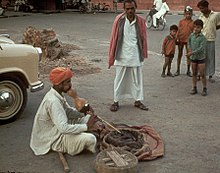Pungi


The pungi (Hindi: पुंगी, Urdu: پُنگی, Burmese: ပုန်ဂိ), bīn (Hindi: बीन) or Murli (Sindhi: مُورلي) is a musical instrument that originates from the Indian subcontinent. The instrument consists of a reservoir into which air is blown and then channelled into two reed pipes. It is played with no pauses, as the player employs circular breathing. In street performances, the pungi is used for snake charming.[1][2]
History
The pungi[3][4][5] is a Hindu folk music reed pipe instrument[6] that is mostly played by cobra charmers[7] in Sindh and Rajasthan.[8] The instrument is made from a dry hollowed gourd with two bamboo attachments.[9] It is also a double-reed instrument.[10] The pungi is played by Jogi in the Thar desert.[11]
It is in particular played by snake charmers, mostly in the Terai and Nepal, to arouse snakes to dance.[12]
The instrument has a high, thin tone and continuous low humming.[13]
It has been an important instrument in Indian folk culture and is known by various names in different parts of India. In northern India, it is known as the been, tumbi, and bansi; in the southern India, it is known as the magudi, mahudi, pungi, and pambaattikulhal.[14]
Construction

The pungi is constructed from a solid coconut cover, to which pieces of bamboo are joined, and has two components: a hollow vessel constructed from a gourd, and two pipes, each with a free-beating single reed (jivala).
The player blows air through the top tube-like portion of the instrument. One pipe makes drone-like sounds. and the other produces the melody. The pipe that produces the melody has seven holes and a range of one octave. The drone pipe only has one hole. Traditionally, both sounds are played simultaneously using circular breathing to create a hypnotic effect.
The pungi is usually played solo, as it is difficult to play it with other instruments.[15]
Ban on snake charming
The instrument was often used to entertain the public with snake charming. However, this practice was eventually banned throughout the country in 1991, under the Wildlife Protection Act, 1972.[citation needed]
See also
References
- ^ "Here's A Really Important Thing You Need To Know About Snake Charming". Hand Luggage Only. 26 January 2016. Retrieved 7 September 2020.
- ^ "FYI: Can Snakes Really Be Charmed By Music?". Popular Science. 12 September 2013. Retrieved 7 September 2020.
- ^ "A Seductive Musical Affair – The UrbanWire". The UrbanWire. 1 June 2010. Retrieved 7 April 2018.
- ^ Manzar, Osama (2 March 2016). "Social media can save folk and oral wisdom". Mint. Retrieved 7 April 2018.
- ^ "Fading sounds of tribal rhythms - Times of India". The Times of India. Retrieved 7 April 2018.
- ^ Avtar, Ram (1983). Musical instruments of India: history and development. Pankaj Publications.
- ^ "Our dying cultural heritage - The Express Tribune". The Express Tribune. 9 July 2011. Retrieved 7 April 2018.
- ^ "Fusion of styles, cultures & continents at this year's International Folk Festival - The Sunday Guardian Live". The Sunday Guardian Live. 22 October 2016. Retrieved 7 April 2018.
- ^ Balocu, Nabī Bak̲h̲shu K̲h̲ānu (2012). Musical Instruments of the Lower Indus Valley of Sindh. Culture Department, Government of Sindh.
- ^ Booth, Gregory D.; Shope, Bradley (2014). More Than Bollywood: Studies in Indian Popular Music. Oxford University Press. ISBN 9780199928835.
- ^ "Transcendental tradition: Under the spell of Sindhi snake charmers". The Express Tribune. 14 October 2013. Retrieved 7 April 2018.
- ^ "Nepali Musical Instruments - We All Nepali". We All Nepali. Archived from the original on 23 January 2023.
- ^ "Asian Sub-continent: India, Pakistan". www.rootsworld.com. Retrieved 8 April 2018.
- ^ Post, Like This. "Pungi or Been". Schoolchalao.com. Retrieved 22 April 2021.
- ^ "Details - India Instruments". India-instruments.com. Retrieved 22 April 2021.
